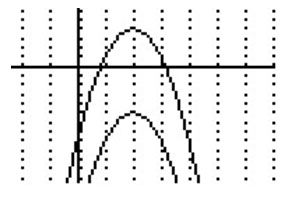
What happens if we change “k” in f(x) = a(x – h)2 + k?
The parameter “k” translates (moves) the graph vertically.
Describe the effect on the graph of y = -3(x – 2)2 + 4 if the equation is changed to
y = (x - 2)2 - 5?
Solution
Comparing the two equations, they differ only by the last constant, which is “k”.
Remember that “k” ONLY affects vertical movement of the graph.
In the first equation, y = - 3(x – 2)2 + 4 ⇒ k = 4. This graph lays 4 units above the origin.
In the second equation, y = - 3 (x − 2)2 – 5 ⇒ k = -5. This graph lays 5 units below the origin.
The parabola has been translated from 4 units above the origin to 5 units below the origin.
To find the distance the parabola has moved we subtract ⇒ 4 − -5 = 4 + 5 = 9.
Therefore, the graph of the equation y = - 3(x – 2)2 + 4 has been translated down 9 units.

If the graph of f(x) = three-fourths 3 4 (x + 1)2 - 3 is to be translated 2 units down, what is the equation of the new parabola?
Solution
A translation of 2 units down is vertical and affects ONLY the “k” in the equation.
If f(x) = three-fourths 3 4 (x + 1)2 – 3 ⇒ k = -3.
To translate this graph down, you should subtract from “k”.
Starting at -3 and moving down 2 units gives you -3 – 2 = -5, so the new “h” is -5
New equation: f(x) = three-fourths 3 4 (x + 1)2 + -5 which simplifies to f(x) = three-fourths 3 4 (x + 1)2 - 5